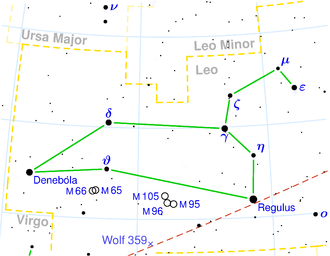IC 610
| Galaxy IC 610 / IC 611 |
|
|---|---|

|
|
| SDSS recording | |
| AladinLite | |
| Constellation | lion |
|
Position equinox : J2000.0 , epoch : J2000.0 |
|
| Right ascension | 10 h 26 m 28.4 s |
| declination | + 20 ° 13 ′ 41 ″ |
| Appearance | |
| Morphological type | Sc / HII |
| Brightness (visual) | 14.0 mag |
| Brightness (B-band) | 14.8 mag |
| Angular expansion | 1.8 ′ × 0.3 ′ |
| Position angle | 29 ° |
| Surface brightness | 13.2 mag / arcmin² |
| Physical data | |
| Redshift | 0.003903 ± 0.000018 |
| Radial velocity | 1170 ± 5 km / s |
|
Stroke distance v rad / H 0 |
(49 ± 4) · 10 6 ly (15.0 ± 1.1) Mpc |
| history | |
| discovery | Lewis Swift |
| Discovery date | April 20, 1889 |
| Catalog names | |
| IC 610 • 611 • UGC 5653 • PGC 30670 • CGCG 094-052 • 124-020 • MCG + 03-27-034 • IRAS 10237 + 2028 • 2MASX J10262836 + 2013417 • NSA 109227 • LDCE 724 NED011 | |
IC 610 = IC 611 is a spiral galaxy with extensive star formation regions of the Hubble type Sbc in the constellation Leo on the ecliptic . It is around 49 million light years away from the Milky Way and has a diameter of around 30,000 light years .
In the same area of the sky are u. a. the galaxies NGC 3226 and NGC 3227 .
The object was discovered by Lewis Swift on April 20, 1889 .
